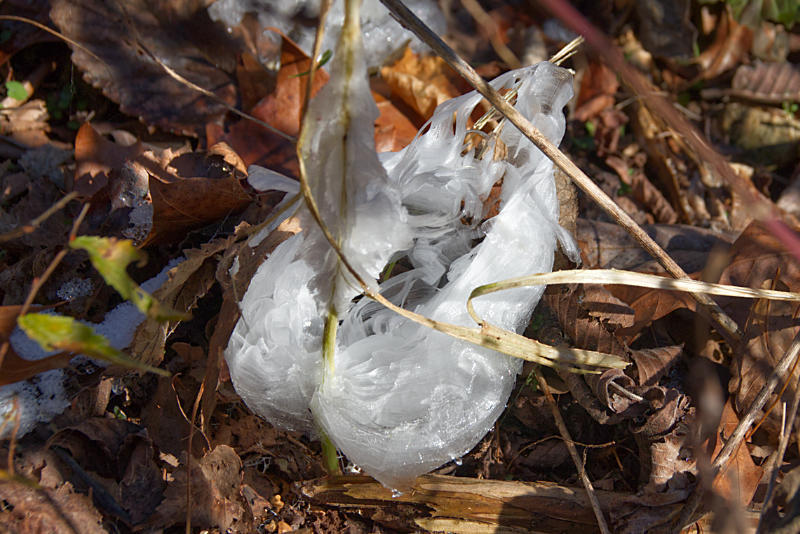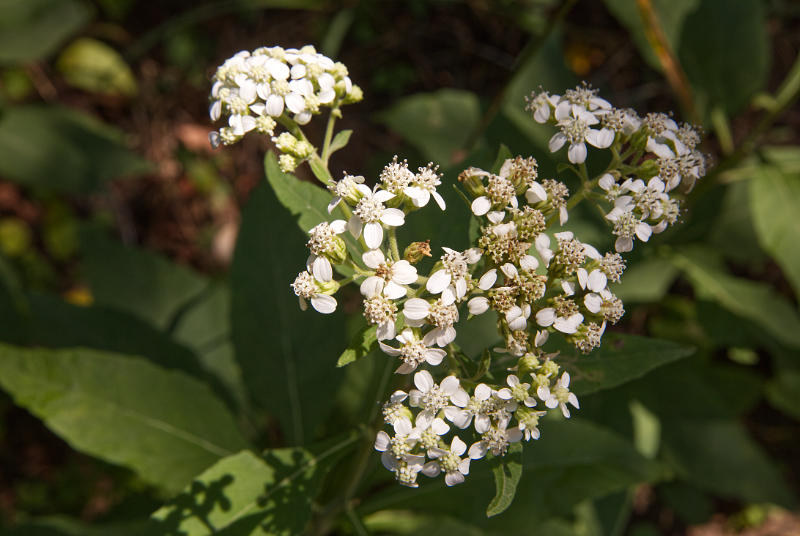
Frostweed, the plant that “magically” creates icy formations in winter, may seem like it’s straight out of a fairy tale. But this curious plant is very real and has some surprising properties that make it stand out from other wildflowers. In this article, we’ll delve into the world of frostweed, exploring its fascinating characteristics and uncovering the secrets behind its icy formations. If you’ve ever wondered how this intriguing plant works or how it could benefit your garden, keep reading!
Frostweed, or Verbesina virginica, is an herbaceous wildflower native to the eastern half of North America. A perennial, frostweed is a hardy, fast-growing plant that thrives in sunny, well-drained soil. It is often found on roadsides, fields, and other disturbed areas.
Frostweed has been named for its propensity to form dramatic ice sculptures on cold winter days. On sunny days, the plant’s thick stems will exude a milky-white sap that quickly solidifies in cold temperatures. As the sap freezes and expands, the stems will split into several pieces, forming intricate patterns of ice known as “frost flowers”. The thick stems of the plant can remain frozen for days, making for a truly spectacular sight.

Frostweed is a member of the Asteraceae family. It produces heads of white flowers in late summer through fall. Flower heads consist of multiple flowers arranged in a cluster at the end of the stems. The leaves of frostweed are oval-shaped, with a dark green color and a light underside.
Frostweed is an important plant for a variety of wildlife species, providing food and shelter for birds, mammals, and insects. It is one of a few plants that flower into Autumn and is important for Monarch butterflies on their fall migration.
In addition, the plant has many medicinal uses. It is believed to have anti-inflammatory, antiseptic, and pain-relieving properties.
Frostweed is an easy-to-grow wildflower that is sure to add a beautiful touch to any garden. It prefers full sun and well-drained soil. It will spread quickly if given the right conditions. With its dramatic ice sculptures, vibrant blooms, and medicinal properties, frostweed is an excellent addition to any landscape.
Uses of Frostweed in the Garden
Frostweed is an ornamental plant that can be used in a variety of ways in your garden. The plant’s bright white flowers and deep green foliage make it an attractive addition to any garden. Plus, its unique ability to form ice crystals on its stems can be a great way to add some visual interest to your garden in the winter months.
The best way to use frostweed in your garden is as a perennial border plant. Frostweed’s upright habit and hardiness make it ideal for this use. It can tolerate some shade but will thrive in full sun. Plant it in well-drained soil and it will thrive with regular watering.
Frostweed can also be used as an accent plant in your garden. Its unique ice crystal formations make it an eye-catching addition to the garden. Plant it near a walkway or entryway to your home to create a beautiful display. It’s also a great choice for a container garden or planter.
Another great use for frostweed is as a cut flower. Its bright white flowers and tall stems make it a great choice for bouquets. The flowers are also quite fragrant, so they make a great addition to floral arrangements.
Finally, frostweed can be used in a variety of other ornamental applications. Plant it near a pond or water feature to create a beautiful display. You can also use it as a ground cover in areas where you want to keep weeds out. Or, you can use it as a focal point in your garden.
Frostweed is a versatile and attractive plant that can be used in a variety of ways in your garden. With its bright white flowers, deep green foliage, and unique ice crystal formations, it’s sure to be a showstopper in your landscape.

How to Grow Frostweed in the Garden
Habitat
Growing this striking wildflower requires specific habitat requirements, and with a little knowledge and effort, you can have a beautiful display of Frostweed in your own backyard.
The best habitat is in moist, sunny meadows and open woodland areas with plenty of sun and air circulation. This wildflower prefers moist, well-draining soils with plenty of organic matter, and it does not tolerate soggy conditions. It will not bloom if the soil is too dry or too wet, so it is important to monitor soil moisture.
Frostweed is best suited to areas with temperate climates, although it can be grown in more extreme climates with some modifications. In hotter climates, it is important to give Frostweed protection from the afternoon sun and provide plenty of water during dry spells. In colder climates, planting it in a protected spot with plenty of snow cover will provide extra insulation and help your plants survive the winter.
Frostweed is a short-lived perennial, so it is important to provide it with plenty of nutrients. Fertilizing with a slow-release, low-nitrogen fertilizer will help promote healthy growth and encourage blooms. Mulching around the plants with organic material such as compost or bark chips will help keep the soil moist and reduce the need for frequent watering.
Frostweed is a self-seeding plant, so you will need to keep an eye on it and remove any unwanted seedlings. If left to its own devices, it can become invasive in some areas.
Soil and Light Requirements
Frostweed is a hardy, native wildflower that typically grows in sunny, open areas. It is tolerant of a wide range of soils, but it prefers well-drained soil with a neutral pH. To ensure Frostweed thrives in your garden, it’s important to prepare the soil ahead of time. Dig the soil up to a depth of 6 inches and remove any weeds or debris. Amend the soil with organic matter such as compost or manure. This will help improve drainage and water-holding capacity.
When it comes to light requirements, Frostweed does best in full sun. It will tolerate partial shade but may produce fewer blooms. If you are planting Frostweed in a shady area, make sure it receives at least 6 hours of direct sunlight each day.
Frostweed is a low-maintenance wildflower that is easy to grow. With the right soil and light requirements, it can be an attractive addition to any garden.
Propagation
Propagating Frostweed (Verbesina virginica) is a rewarding and enjoyable experience for any wild plant enthusiast. But despite its beauty and hardiness, Frostweed can be a tricky plant to propagate. That’s why it’s important to know the best propagation methods for this species, so you can successfully grow your own Frostweed from seed.
The first step in propagating Frostweed is to collect the seeds. Frostweed blooms in late summer and the seeds are dispersed by the wind. To collect the seeds, simply wait until the flower heads turn brown and dry out. Then, cut the flower heads off and place them in a paper bag. Shaking the bag vigorously will disperse the seeds.
Once the seeds are collected, it’s time to sow them. Frostweed prefers a sunny spot with rich, well-drained soil. Sow the seeds in mid-autumn, broadcasting them over the soil surface. Cover them lightly with a thin layer of compost and then water them in.
It is a slow-growing species, so it may take several weeks before you see the first signs of germination. Once the seedlings emerge, thin them to give each plant enough space to grow. Keep the soil moist, but not wet, and fertilize the plants every few weeks with a balanced fertilizer.
Frostweed can also be propagated through division. In late autumn or early winter, dig up the clumps of Frostweed and divide them into smaller pieces. Replant the divisions in the same spot or a new location.
Finally, it can also be propagated from cuttings. Take cuttings from the tips of the stems in late summer or early autumn. Cut the stems into pieces about 4 inches long and strip away the lower leaves. Dip the cuttings in rooting hormone, then plant them in pots of moist potting soil. Place the pots in a sunny spot and keep the soil moist.
If you are interested in learning more about wild plants for gardening, foraging, or medicinal uses be sure and visit our blog.
FAQs:
Q: What is frostweed and what are its uses in the garden?
A: Frostweed (Verbesina virginica) is a native plant found in the eastern part of North America. It is a great addition to any garden as it attracts pollinators, provides food and shelter for wildlife, and has beautiful blooms in late summer and fall.
Q: How do I grow frostweed in my garden?
A: Frostweed is a low-maintenance plant that can be easily grown in the garden. It prefers well-draining soil and full sun to partial shade. It is drought-tolerant once established and doesn’t require much watering. It can be grown from seed or propagated by dividing the roots.
Q: What is the habitat of frostweed?
A: Frostweed is commonly found in woodland and meadow habitats in the eastern part of North America, from Texas to Canada.
Q: What are the soil and light requirements for growing frostweed?
A: Frostweed prefers well-draining soil and full sun to partial shade. It can tolerate a variety of soil types, including sandy and clay soils.
Q: How can I propagate frostweed?
A: Frostweed can be propagated by dividing the roots in the spring or fall. It can also be grown from seed, which should be sown in the fall or early spring.